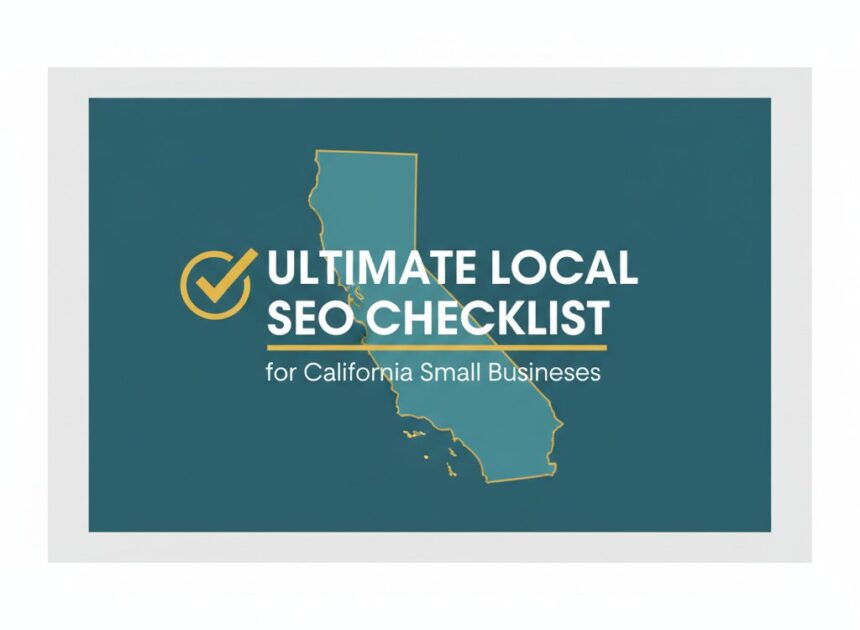Running a small business in California means operating in one of the most dynamic and competitive markets in the world. From San Diego to the Bay Area, thousands of businesses are vying for the same customers. So, how do you make sure they find you first?
The answer is a robust strategy for local SEO in California. This isn’t just about having a website; it’s about making your business the most visible, trusted, and relevant option for customers in your immediate area. This ultimate checklist will give you the actionable steps needed to improve your local search ranking in California and turn online searches into real-world customers.
Part 1: Your Foundational SEO Setup
Before you can build a powerful online presence, you need to lay a solid foundation. This initial setup is crucial because it ensures that search engines like Google can find, crawl, and understand your business information correctly. It also provides you with the essential tools to track your progress and make sure your brand is presented consistently across the web. Getting these fundamentals right is the critical first step for any successful California small business SEO plan.
- Website Health Checks: Make sure your website is mobile-friendly and loads quickly. With so many Californians searching on the go, a slow or clunky mobile site is a deal-breaker.
- Install Analytics: Set up Google Analytics 4 and Google Search Console to track your visitors and monitor your website’s performance in search results.
- Ensure NAP Consistency: Your Business Name, Address, and Phone number (NAP) must be 100% identical everywhere online. This includes your website footer, your Google profile, Yelp, and any other directory. Consistency builds trust with Google.
Part 2: Master Your Google Business Profile (GBP)
Your Google Business Profile (GBP) is the single most powerful and impactful tool for local SEO. Think of it as your digital storefront, business card, and yellow pages listing all rolled into one. For potential customers in California, your GBP listing is often the very first interaction they have with your brand, appearing directly on Google Search and Maps. A completely optimized profile can generate calls, website visits, and foot traffic without the user ever needing to look further.
- Complete Every Section: Claim your profile and fill out everything. This includes adding your logo, hours, a detailed description of your services, and accessibility information.
- Select Hyper-Specific Categories: Don’t just choose “Contractor.” Choose “Plumbing Contractor” or “Electrical Contractor.” Add secondary categories for all the services you offer.
- Upload Geo-Tagged Photos Weekly: Showcase your work, your team, and your storefront. Use photos taken in Los Angeles, San Diego, or wherever you operate. High-quality images prove you are a legitimate, active business.
- Define Your Service Areas: If you serve customers at their location, specify your service areas. List the cities and counties you cover, like Orange County or specific neighborhoods in San Francisco.
- Use Google Posts: Treat Google Posts like a social media feed. Share offers, events, and blog updates weekly to show Google your business is active.
- Encourage and Answer Q&As: Proactively add common questions and your own answers to the Q&A section to control the narrative and provide helpful information.
Part 3: On-Page SEO: Your Website’s California Connection
On-page SEO refers to the practice of optimizing the actual content, code, and structure of your website pages. While your Google Business Profile gets you on the map, your website is what convinces customers to choose you. This is where you send powerful signals to both search engines and users that you are the local authority for a specific service within a specific part of California. Every page should be strategically optimized to target your local audience.
- Create Hyper-Local Service Pages: Instead of a single “Services” page, build out pages for your top services in your main locations. For example:
- “Boutique Marketing Services in the Bay Area”
- “Commercial Plumbing for Los Angeles Businesses”
- “Residential HVAC Repair in Sacramento”
- Optimize Title Tags and Meta Descriptions: Include your target city or region in the page titles and descriptions that appear in Google search results. This immediately tells searchers you are local and relevant.
- Embed a Google Map: On your contact page, embed an interactive Google Map of your physical location.
- Add Local Business Schema: This structured data markup helps Google understand your NAP, hours, and service type, which can lead to a richer appearance in search results.
Part 4: Building Authority with Local Link Building and Reviews
Beyond your own website, Google heavily weighs what others say about your business. This is your online reputation, and it’s built on two key pillars: what real customers say (reviews) and what other reputable websites say (citations and links). A business with a strong portfolio of positive reviews and consistent citations from trusted sources signals to Google that it is a legitimate and trustworthy local authority, which is a massive factor in ranking highly.
- Get Genuine Customer Reviews: Create a simple system (email, text, QR code) to ask every happy customer to leave a Google review. A steady stream of positive reviews is a massive ranking factor.
- Respond to All Reviews: Thank positive reviewers and professionally address negative feedback. It shows you are engaged and care about customer service.
- Build Local Citations: Get your business listed on relevant directories like Yelp, Apple Maps, and Bing Places. Then, look for California-specific or industry-specific directories.
- Earn Local Backlinks: A link from another local business is incredibly valuable. Sponsor a local event, join the California Chamber of Commerce, or partner with a neighboring business on a promotion to earn a link from their website.
Part 5: The California Advantage: Hyper-Local Content
Generic content simply won’t work in a state as large and diverse as California. To truly connect with your audience and stand out, you must go beyond basic SEO and create a hyper-local content strategy. This means demonstrating a deep understanding of the local market—from the unique culture of Southern California (SoCal) to the tech-savvy environment of Silicon Valley. This is how you connect with customers on a level that national chains and generic competitors simply cannot.
- Write Geo-Targeted Blog Posts: Create content that is genuinely useful for Californians.
- An LA fitness studio: “5 Best Hiking Trails Near Los Angeles to Complement Your Workout.”
- A Bay Area financial advisor: “Navigating California’s State Tax Laws for Tech Startups.”
- Consider Bilingual SEO: In many parts of California, a significant portion of your customer base may search in Spanish. Creating Spanish-language landing pages can unlock a huge new audience.
Your Path to Local Dominance
Mastering local SEO in California takes consistent effort, but the reward is a steady stream of local customers who are actively searching for your services. This checklist is your roadmap.
Feeling overwhelmed? You don’t have to do it alone. The team at Revix Solutions specializes in creating targeted SEO strategies for competitive markets.
Contact us today for a Free SEO Website audit of your website and see how we can help you dominate the local search results in California.







